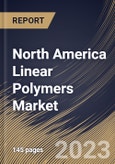These polymers consist of prolonged chains of repeating units, characterized by a linear or unbranched structure, where the polymer chains are formed by linking monomer units together through chemical bonds. These monomer units are repeated linearly, resulting in a straight or slightly curved chain-like structure. The growth of these end-use industries, driven by population growth, urbanization, rise in disposable income, and technological advancements, contributes to a surge in demand for linear polymers. These polymers offer strength, flexibility, chemical resistance, thermal stability, and processability, making them suitable for a wide range of applications.
One of the primary factors influencing the behavior of these polymers is their molecular weight. As the length of the polymer chain grows, so does its molecular weight. Higher molecular weights often improve mechanical properties, such as increased tensile strength and toughness. However, processing and handling become more challenging with larger molecular weights, necessitating a balance based on the intended application. They exhibit a straightforward, unbranched structure, allowing for a more organized and predictable packing of chains. This linear arrangement imparts specific properties, including good solubility, clarity, and ease of processing during manufacturing.
According to Select USA, in 2020, US light vehicle sales were 14.5 million units. The US is the world's second-largest vehicle sales and production market. Autos Drive America declares that international automakers produced 5 million vehicles in the US in 2020. The automotive industry has been increasingly focused on lightweight to improve fuel efficiency and reduce emissions. These polymers, known for their lightweight properties, are used in various components to help achieve these goals without compromising strength and safety. The above aspects will expand the market growth across the region in the upcoming years.
The US market dominated the North America Linear Polymers Market by Country in 2022 and would continue to be a dominant market till 2030; thereby, achieving a market value of $67,020.9 million by 2030. The Canada market is experiencing a CAGR of 5.7% during (2023 - 2030). Additionally, The Mexico market would exhibit a CAGR of 4.8% during (2023 - 2030).
Based on Manufacturing Process, the market is segmented into Addition Polymerization, Ring-Opening Polymerization, Emulsion Polymerization, and Condensation Polymerization. Based on Type, the market is segmented into Polyethylene, Polyamides, Polystyrene, Polyvinyl Chloride (PVC), and Others. Based on End User, the market is segmented into Packaging, Electronics, Automotive, Construction, Healthcare, Agriculture, and Others. Based on countries, the market is segmented into U.S., Mexico, Canada, and Rest of North America.
The market research report covers the analysis of key stake holders of the market. Key companies profiled in the report include BASF SE, Chevron Phillips Chemical Company LLC, Exxon Mobil Corporation, Formosa Plastics Group, INEOS Group Holdings S.A., LG Chem Ltd. (LG Corporation), LyondellBasell Industries Holdings B.V., SABIC (Saudi Arabian Oil Company), The Dow Chemical Company and Total Energy Services Inc.
Scope of the Study
Market Segments Covered in the Report:
By Manufacturing Process- Addition Polymerization
- Ring-Opening Polymerization
- Emulsion Polymerization
- Condensation Polymerization
- Polyethylene
- Polyamides
- Polystyrene
- Polyvinyl Chloride (PVC)
- Others
- Packaging
- Electronics
- Automotive
- Construction
- Healthcare
- Agriculture
- Others
- US
- Canada
- Mexico
- Rest of North America
Key Market Players
List of Companies Profiled in the Report:
- BASF SE
- Chevron Phillips Chemical Company LLC
- Exxon Mobil Corporation
- Formosa Plastics Group
- INEOS Group Holdings S.A.
- LG Chem Ltd. (LG Corporation)
- LyondellBasell Industries Holdings B.V.
- SABIC (Saudi Arabian Oil Company)
- The Dow Chemical Company
- Total Energy Services Inc.
Unique Offerings
- Exhaustive coverage
- The highest number of Market tables and figures
- Subscription-based model available
- Guaranteed best price
- Assured post sales research support with 10% customization free
Table of Contents
Companies Mentioned
- BASF SE
- Chevron Phillips Chemical Company LLC
- Exxon Mobil Corporation
- Formosa Plastics Group
- INEOS Group Holdings S.A.
- LG Chem Ltd. (LG Corporation)
- LyondellBasell Industries Holdings B.V.
- SABIC (Saudi Arabian Oil Company)
- The Dow Chemical Company
- Total Energy Services Inc.
Methodology

LOADING...








